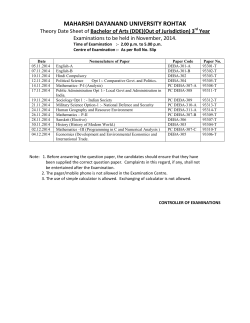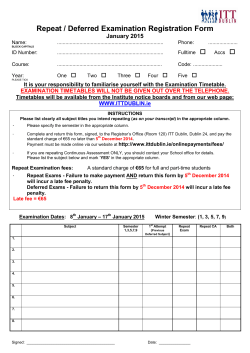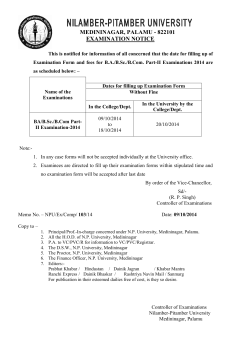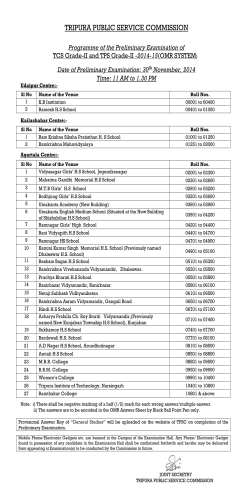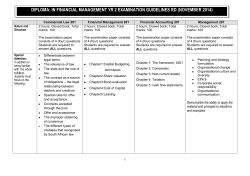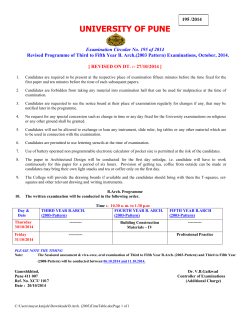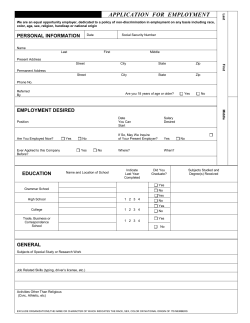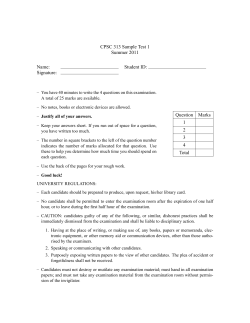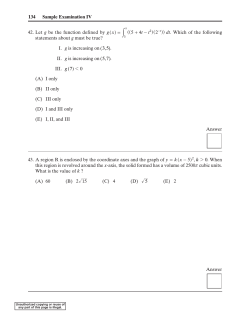
Practice of Professional Engineering Examination 2015
Professional Engineers Registration Examination PRACTICE of Professional Engineering Examination 2015 Information for Applicants professional engineers board Singapore 5 Maxwell Road 1st storey Tower Block MND Complex Singapore 069110 Page 1 Professional Engineers Registration Examination Practice of Professional Engineering Examination 2015 Information for Applicants Contents Page 1 Introduction ....................................................................................... 2 2 Description of Examination .................................................................. 2 3 Eligibility to Sit for Examination ............................................................ 2 4 Fees .................................................................................................. 3 5 Date of Examination ............................................................................ 3 6 Venue ................................................................................................ 3 7 Application ......................................................................................... 3 8 Structure of Examination ..................................................................... 3 9 Passing Requirements Final Results and Notification .............................. 4 10 Examination Appeals ………………………………………………………………….……..4 11 Review Courses …………………………………………………..………..4 12 Refund of Fees ……………………………………………………….…...5 Annex A: FORMAT, SYLLABUS AND SAMPLE QUESTIONS I Practice of Professional Engineering Examination - Part 1 (Common)…………. 6 II Practice of Professional Engineering Examination - Part 2 (Civil) .....................9 III Practice of Professional Engineering Examination - Part 2 (Electrical) .......... 20 IV Practice of Professional Engineering Examination - Part 2 (Mechanical)....... 31 Professional Engineers Registration Examination PPE 2015 Page 2 Professional Engineers Registration Examination Practice of Professional Engineering Examination 2015 Information for Applicants 1 INTRODUCTION The mission of the Professional Engineers Board is to safeguard life, property, and welfare of the public by setting and maintaining high standards for registering professional engineers and by regulating and advancing the practice of professional engineering. The Professional Engineers Board registers professional engineers in the branches of civil, electrical and mechanical engineering. A person applying for registration as a professional engineer to the Professional Engineers Board is required to hold an approved degree or qualification listed in the Professional Engineers (Approved Qualifications) Notification and acquired not less than 4 years of relevant practical experience. He is also required to sit and pass examinations prescribed by the Board. The applicant is required to sit and pass the Fundamentals of Engineering Examination and following that, to sit and pass the Practice of Professional Engineering Examination. In addition, the applicant is required to attend an interview. The following sections set out the requirements and details for the Practice of Professional Engineering Examination 2015 while details on other application requirements are available on the PEB website at www.peb.gov.sg. 2 DESCRIPTION OF EXAMINATION The Practice of Professional Engineering Examination tests the applicant’s ability to apply his knowledge and experience in professional engineering practice, and his knowledge of the rules and regulations regulating the practice of professional engineering in civil, electrical or mechanical engineering. 3 ELIGIBILITY TO SIT FOR EXAMINATION A person may apply to sit for the Practice of Professional Engineering Examination after he has- 4 (a) obtained not less than 3 years (in aggregate) of practical experience in engineering work relevant to the branch of engineering that he seeks to be registered in; and (b) sat for and passed the Fundamentals of Engineering Examination. FEES Professional Engineers Registration Examination PPE 2015 Page 3 The fee for an application to sit for the Practice of Professional Engineering Examination is $450. 5 DATE OF EXAMINATION The dates for the Practice of Professional of Engineering Examination 2015 are: a) b) c) 6 Civil Engineering – 13 May 2015 Electrical Engineering – 13 May 2015 Mechanical Engineering – 13 May 2015 VENUE The venue would be determined by PEB and successful applicants would be informed of the details of the venue. 7 APPLICATION Application and payment shall be made online at PEB’s website by 7 March 2015. All required documents are to be submitted to PEB within a week after application is made online. Applicants are advised to send in their applications early to allow time for processing. They would be informed of the status of their applications and other details by post at least two weeks before the examinations. 8 STRUCTURE OF EXAMINATION A summary of the structure of the Practice of Professional Engineering Examination 2015 is shown in the table below. The examination is ‘open book’ and further details are given in Annex A: Format, Syllabus and Sample Questions. Subjects PPE Part 1 Common paper Time Allocated 2 hrs 10 mins (9.00 am – 11.10 am) Professional Engineers Registration Examination PPE 2015 Format Answer 10 compulsory Multiple Choice Questions Answer 3 out of 5 essay questions Page 4 PPE Part 2 Civil/mechanical/electrical engineering 9 10 4 hrs 10 mins (1.00 pm – 5.10 pm) Answer 1 compulsory question plus 4 out of 7 questions PASSING REQUIREMENTS, FINAL RESULTS AND NOTIFICATION (a) A candidate is required to take both Parts 1 and 2 when he sits for the examination unless he qualifies for an exemption as described in (b) below. Examination results will be given to candidates on a Pass/Fail basis and no scores or marks will be given to candidates. To obtain a ‘Pass’ in the examination, a candidate is required to obtain a pass score in both Parts 1 and 2 respectively. (b) A candidate who has taken both parts when he sits for the examination and obtains a pass score in only one of the two parts is deemed to have failed the examination. However, if he sits for the examination again, he would be granted an exemption from the part for which he has obtained a pass score. This exemption shall be granted provided the candidate sits for the examination again within a 3-year period from the date of result. With the exemption, he would only need to take the part of the examination for which he did not obtain a pass score. No exemption shall be granted if he sits for the examination again after the exemption period, in which case he is required to take both Parts 1 and 2. (c) Examination results will be mailed to the candidates within twelve weeks after the examination. EXAMINATION APPEALS A candidate who has failed the examination may submit a written appeal to review his/her performance together with a payment of $25. The appeal is to be made within 2 weeks after the receipt of results and late appeals would not be considered. The result of the appeal/review will be sent by written mail to the appeal candidate. The appeal candidate would not be able to review his examination paper. 11 REVIEW COURSES The Board does not endorse any review course or material provided as study aids. 12 REFUND OF FEES Professional Engineers Registration Examination PPE 2015 Page 5 Where an applicant who has been accepted is unable to sit for the examination subsequently, the Board may, at its discretion, refund $150 to the applicant if the applicant informs the Board at least a week before the examination or submit a medical certificate by mail within 2 weeks after the examination. There will be no refund if the applicant informs the Board less than a week before the examination or send scanned copy of medical certificate via email. Professional Engineers Registration Examination PPE 2015 Page 6 Annex A: FORMAT, SYLLABUS AND SAMPLE QUESTIONS I Practice of Professional Engineering Examination Part 1 (Common) Professional conduct and ethics are important areas because most of the disciplinary actions taken by the Professional Engineers Board are in the area of ethics and not technical matters. Professionalism and ethics are closely related and inseparably bound as professional status and recognition are based on public interest. A professional engineer’s judgment and decisions can have great impact on public health and safety. He is expected to uphold the dignity, standing and reputation of the profession. He shall practise ethically in relation to his clients, employers, fellow professionals and the public at large. Format This is a common paper which has two sections on the Professional Engineers Act and Professional Conduct and Ethics. The paper comprises 10 multiple choice questions (MCQs) and 5 essay type questions based on hypothetical case studies. The candidates must answer all the 10 compulsory MCQs (25 marks) and can choose to answer any 3 out of the 5 essay questions (75 marks) during the 2 hrs 10 mins examination period. Syllabus The paper will focus on the latest revisions of the following Professional Engineers Act and Rules: - Professional Engineers Act - Professional Engineers (Code of Professional Conduct and Ethics) Rules - Professional Engineers Rules References will also be made to past disciplinary actions taken by the Professional Engineers Board arising from complaints against professional engineers. Questions will be set to test the candidates’ understanding and interpretation of the provisions in the act and rules as well as how they will tackle hypothetical cases involving the clients, the employers, fellow professionals and the public at large. Professional Registration Examination PPE 2015 Page 7 Sample Questions From Past Year Papers for Practice of Professional Engineering Examination Part 1 (Common) Section A - Answer 10 Compulsory Multiple Choice Questions (Total : 25 marks) 1 Under what circumstances shall a professional engineer advise the client to engage the services of experts and specialists? (a) The professional engineer shall give the advice when in his opinion and judgment such services are in the interest of his client. (b) The professional engineer shall give the advice when he feels such services will pass the responsibility to others. (c) The professional engineer shall give the advice when he ican indirectly benefit from the appointment of experts and specialists. (d) The professional engineer shall give the advice when he considers that in doing so the cost input of his company will be reduced. 2 A professional engineer may publicise his practice. However, in doing so, the professional engineer shall ensure that the publicity — (a) contains information that is related to all the projects undertaken by him or his company but without the consent of the clients. (b) contains only information beneficial to his business even though it is likely to diminish public confidence in the engineering profession or to otherwise bring the profession into disrepute. (c) contains only justifiable claims to expertise or specialization; makes no reference to past project information which constitutes a breach of confidentiality to the client; and does not compare or criticise the quality of services provided by any other professional engineer or allied professional. (d) contains information with material facts even if it may create an unjustified expectation about the results that can be achieved by him. 3 Engineer A provides design, plans and specifications for a commercial building to Developer P who submits them to the authority for approval but fails to pay Engineer A for the work performed. Thereafter, Developer P asks Engineer B to review, endorse and resubmit the plans to the authority for approval. Shall Engineer B agree to undertake the project? (a) Engineer B shall not agree to undertake the project as he has an ethical obligation to recognise and give credit to the creative works of other engineers. Professional Registration Examination PPE 2015 Page 8 (b) Engineer B shall agree to undertake the project as long as Engineer A does not complain. (c) Engineer B shall agree to undertake the project as Engineer A does not know. (d) Engineer B shall agree to undertake the project as he is employed by the Developer. Section B - Answer 3 Out Of 5 Essay Questions Question 1 Engineer A, on behalf of the engineering firm of which he is a principal, submitted a statement of qualifications to a developer for a mega project. In due course he was notified that his firm was on the "short list" for consideration along with several other firms, but it was indicated to him that his firm did not appear to have qualifications in some specialised aspects of the requirements, and that it might be advisable for the firm to consider a joint venture with another firm with such capabilities. Engineer A thereupon contacted Engineer B, a principal of a firm with the background required for the specialised requirements, and inquired if Engineer B’s firm would be interested in a joint venture if Engineer A was awarded the job. Engineer B’s firm responded in the affirmative. Thereafter, Engineer C, a principal in a firm which was also on the "short list," contacted Engineer B and indicated the same requirement for a joint venture for specialised services, and also asked if B’s firm would be willing to engage in a joint venture if the C’s firm was selected for the assignment. Engineer B also responded in the affirmative to Engineer C but did not notify Engineer A of his response to Engineer C. Is it ethical for Engineer B to agree to participate in a joint venture arrangement with more than one of the several since he did not make a full disclosure to all of the firms? Discuss the issues and comment on Engineer B‘s conduct with reference to relevant sections of the Professional Conduct and Ethics rules where applicable. (25 marks) Professional Registration Examination PPE 2015 Page 9 II Practice of Professional Engineering Examination Part 2 (Civil) The paper aims to examine the candidates on their proficiency in the practice of civil/structural engineering at a professional level. Candidates are expected to have a good working knowledge and experience of civil/structural engineering design and practices in Singapore. In particular knowledge is required in the areas of regulatory framework, submission and approval procedures, statutory acts and regulations, practices guidelines and codes of practice. The examination will place emphasis on the Professional Engineer’s role in building projects in the local context either acting as the Qualified Person for the project or Professional Engineer for the civil and structural engineering works. Format This is a 4 hrs 10 mins paper and a candidate is required to answer 1 compulsory question covering the design of concrete and steel structures and choose 4 out of 7 questions covering areas of design, codes of practice, acts and regulations, submission/approval procedures & site supervision. The candidates may bring along their own reference materials and calculators as necessary. Syllabus The list of reference literature, codes, acts, regulations, etc appended below is meant as a guide and is not exhaustive. Acts and Regulations Professional Engineers Act and Regulations Building Control Act and Regulations Publications URA - Planning Control Handbooks and Guidelines for Building Works SCDF - Code of Practice for Fire Precautions in Buildings - Handbook on Fire Precautions in Buildings - FSSD Fire Safety Handbooks LTA - Guidelines & Publications on Rapid Transit Systems Professional Engineers Registration Examination PPE 2015 Page 10 - Building Works & Restricted Activities in Railway Protection Zone Street Proposals Vehicle Parking Other Guidelines and Standards NEA - Code of Practice on Environmental Health - Code of Practice on Pollution Control PUB - Code of Practice on Surface Water Drainage - Standard Specifications for Drainage Works - Code of Practice on Sewerage and Sanitary Works - Sewerage and Drainage Standard Drawings NParks - Procedures and Guidelines for Plan Submissions MOM - Workplace Safety & Health Act and Subsidiary Legislations BCA - National Productivity and Quality Specification (NPQS) - Guidelines and Handbooks on Civil Defence Shelters - Code of Practice on Buildable Design Civil Engineering Codes/Standards - Codes and Standards under Building Control Act and Regulations - Codes and Standards for Roads and Transit Systems to LTA's Requirements Professional Registration Examination PPE 2015 Page 11 Sample Questions From Past Year Papers for Practice of Professional Engineering Examination Part 2 (Civil) Section 1- Question 1 is COMPULSORY Professional Registration Examination PPE 2015 Page 12 Professional Registration Examination PPE 2015 Page 13 Professional Registration Examination PPE 2015 Page 14 Professional Registration Examination PPE 2015 Page 15 Section 2 - Answer 4 Out Of 7 Questions Professional Registration Examination PPE 2015 Page 16 Professional Registration Examination PPE 2015 Page 17 Professional Registration Examination PPE 2015 Page 18 Professional Registration Examination PPE 2015 Page 19 Professional Registration Examination PPE 2015 Page 20 III Practice of Professional Engineering Examination Part 2 (Electrical) The paper aims to examine the candidates on their proficiency in the practice of electrical engineering at a professional level. Candidates are expected to have a good working knowledge and experience of electrical engineering design and practices in Singapore. In particular knowledge is required in the areas of regulatory framework, submission and approval procedures, statutory acts and regulations, practices guidelines and codes of practice. The examination will place emphasis on the Professional Engineer’s role in building projects in the local context in relation to electrical engineering works. Format This is a 4 hrs 10 mins paper that examines candidates on technical competency and understanding of standards and codes that are applicable in Singapore for the discipline of electrical engineering. The paper consists of 2 Sections and 8 questions. Candidates must answer questions in both sections (Section 1 and Section 2). Section 1 consists of a compulsory question on CP 5, statutory acts and regulations. Candidate is required to answer this compulsory question. Section 2 consists of 7 questions. Candidates shall choose to answer 4 out of 7 questions. Syllabus Codes of Practice CP 5: Code of Practice for Electrical Installations CP 10: Installation and Servicing of Electrical Fire Alarm System CP 15: Installation, Operation and Maintenance of Escalators CP 39: Installation of MATV for the reception of VHF and UHF Sound and TV CP 88 - 1 : Code of practice for temporary electrical installations - Construction and building sites CP 88 - 2 : Code of practice for temporary electrical installations - Festive lighting, trade-fairs, mini-fairs and exhibition sites CP 88 - 3 : Code of practice for temporary electrical installations - Shipbuilding and ship-repairing yards Professional Registration Examination PPE 2015 Page 21 SS 209: Battery operated emergency power supply for lighting, ventilation and alarm bell of lifts SS 530: Code of practice for energy efficiency standard for building services and equipment. SS531-1: Code of practice for lighting of work places – Indoor. SS531-2: Code of practice for lighting of work places – Outdoor. SS531-3: Code of practice for lighting of work places - Lighting requirements for safety and security of outdoor work places. SS532: Code of practice for the Storage of Flammable Liquids. SS535: Installation, Operation, Maintenance, Performance and Construction Requirements of Mains Failure and Standby Generating System. SS538: Code of practice for maintenance of electrical equipment of electrical installations. SS546: Emergency voice communication system in building. SS 550: Installation, Operation and Maintenance of Electric Passengers and Goods Lifts. SS 551: Code of Practice for Earthing. SS 555-1 : Code of practice for protection against lightning – General requirement. SS 555-2 : Code of practice for protection against lightning – Risk management. SS 555-3 : Code of practice for protection against lightning – Physical damage to structures and life hazard. SS 555-4 : Code of practice for protection against lightning – Electrical and electronic systems within structures. SS 558: Code of practice for construction, installation, operation and maintenance of intruder alarm systems. SS 563-1: Code of practice for the design, installation and maintenance of emergency lighting and power supply systems in buildings. Part 1 : Emergency lighting. SS 563-2: Code of practice for the design, installation and maintenance of emergency lighting and power supply systems in Professional Registration Examination PPE 2015 Page 22 buildings. Part 2 : Installation requirements and maintenance procedures. SS 564 - 1 : Green data centres - Part 1 : Energy and environmental management systems SS 564 - 2 : Green data centres - Part 2 : Guidance for energy and environmental management systems SS 576: Code of practice for earthworks in the vicinity of electricity cables. Electricity Act Electricity (Electrical Installations) Regulations Handbook for Application of Installation Licence, published by EMA Fire Code 2013 & Fire Code 2013 Handbook BCA Green Mark Assessment Criteria published by BCA Code on Accessibility in the Built Environment 2013 published by BCA Handbook for solar photovoltaic system (PV) Systems, published by BCA and EMA How to Apply for Electricity Connection, published by SP PowerGrid Ltd Code of Practice for Info-communication Facilities in Buildings (2013) or COPIF 2013 published by IDA Electrical Power Supplies, Tariffs and Design Electricity market Generation, transmission and distribution in Singapore Electricity bill calculation for HT and LT consumers Design of electrical installations Load estimation Power factor correction Professional Registration Examination PPE 2015 Page 23 Power quality and power system harmonics Consumer Substation, Switchboards and Switchgears Maintenance of electrical equipment, switchgears and cables Design for energy efficiency and sustainability Lighting requirement for workplace, indoor and outdoor Visual needs for safety and security Determine the lighting requirements for indoor and outdoor work places. Energy efficiency and accessibility requirement for buildings Minimum energy-efficiency requirements for new installation and replacement of systems and equipment in buildings Replacement of components of systems and equipment in buildings Criteria for determining compliance with energy efficiency in building with regards to air-conditioning and heat rejection equipment, water heaters, motor drives and lighting used in buildings. Requirement and guidelines for buildings to be designed or retrofitted to provide accessibility and safety to persons with disabilities and families with young children. Protection for Safety Measures in protection against electric shock (direct and indirect) Principle of operation of protective devices Maximum demand and diversity factors Protection against over-current and short circuits Protective devices and circuit conductors Discrimination in protection of electrical circuits Cables, Busways, and Distribution Boards Type and characteristic of cables Professional Registration Examination PPE 2015 Page 24 Method of installation Sizing of conduit and trunking Factors affecting the current carrying capacity of cables Sizing of cables and busways for use under different types of conditions Connected load, maximum demands and circuit breakers ratings for a electrical distribution board Earthing Purpose of earthing Methods of earthing Earth fault loop impedance and earth fault current Suitable sizes of circuit protective conductor Testing of earthing Lightning Protection Systems Rolling sphere technique of determining zones of protection Spacing of air terminations and types of air termination Down conductors for building below 45 metres and those exceeding 45 metres Earth electrodes, earth resistance values and hazards of a rise in ground potential caused by lightning strike Selection of appropriate materials and installation methods Prevention of side flashing Design requirement of complete lightning protection system Transients and surge suppression Effect of lightning on system and structure Source and type of damages due to lightning Professional Registration Examination PPE 2015 Page 25 Risk assessment aspect in lightning protection Emergency Lighting Exit and emergency lighting requirements for evacuation of occupants Types of back-up power supplies Exit and directional Signs Standby Power Generator System Types of essential and critical loads Sizing of generator with considerations for maximum demand of essential load, transient or motor starting loads and voltage dip Voltage regulation and its effects on generator sizing Protection for alternator and prime mover Installation of standby generator system including day-tank, battery and charger, fuel supply, engine cooling system, plant room ventilation, exhaust and fresh air intake, control and instrumentation panel and automatic transfer switch. Underground fuel storage system Grounding/Earthing arrangement Maintenance Automatic Fire Alarm System Requirement for automatic and manual fire detection system and purpose of compartmentation as required by the Fire Code Interaction with other building services such as emergency voice communication system, lifts, AHUs, pressurization fans and autodoors during alarm activation Emergency Voice Communication System Requirements for public address system for building above 24 metres but less than 60 metres Requirements for emergency voice communication for building above 60 metres Professional Registration Examination PPE 2015 Page 26 Requirements for fireman intercom Inspection, Testing and Common Violation In Electrical Installation Mandatory requirements for inspection and testing of electrical installation prior to energisation of electrical supply Types of test instruments and standard methods of testing Professional Registration Examination PPE 2015 Page 27 Sample Questions From Past Year Papers for Practice of Professional Engineering Examination Part 2 (Electrical) Section 1 - Question 1 (28 marks) is COMPULSORY Q1. 1(a) Explain the difference and purpose of bonding and earthing as required for an electrical installation in Singapore. You are checking the lightning protection system for a building for compliance to the new code, what is the minimum size of stranded copper bonding conductor allowed to connect the non-ferrous connector point to the earth termination system? 1(b) You are the LEW responsible for the electrical installation in a newly built mixed development. The main switchboard is ready for turn on. Identify the certificate(s) to be submitted to SP Services Ltd (SPS) when you request for an energisation appointment. 1(c) An electrical installation with an approved load of 1000 KVA is taking direct supply from PowerGrid’s network. The low voltage main switchboard (MSB) with air circuit breaker (ACB) had passed the factory acceptance test and was delivered to site; feeder cables were laid and terminated to the MSB. Identify the tests to be carried out on site before requesting for the turn-on by SP Services Ltd (SPS). 1(d) Explain the purpose of the primary injection test. 1(e) Refer to the distribution board shown in Figure Q1(e). A new load, an air handling unit (AHU) rated at 11 kW 3-phase 400V at 0.8 pf, will be added to the distribution board. (i) Is there a need to upgrade the incoming breaker size and the bus bar ratings of the distribution board? State the reason(s) for your answer. (ii) Determine the current rating of the MCB and the cable size for the new AHU. Assume that the cable length from the distribution board to the new AHU is 20m and the permitted Line-Line voltage drop is 8V. (iii) Is there a change in the short-circuit rating of the MCCB in the distribution board when the new load is added? State the reasons for your answer. (iv) How would the LEW in-charge of the operation and maintenance of the electrical installation isolate the distribution board to make it safe for the modification works to be carried out? Professional Registration Examination PPE 2015 Page 28 Elaborate on the procedures and safety measures to be taken before physical works on the distribution board can commence. Figure Q1(e) Professional Registration Examination PPE 2015 Page 29 Section 2 – Answer 4 Out Of 7 Questions (each at 18 marks) Q2. 2(a) You are asked to design an installation where electronic system will be installed and required to comply with electromagnetic compatibility (EMC) requirement. Identify the three criteria for your design? 2(b) Figure Q2(b) shows the basic decomposition of a typical EMC coupling problem where EMC is concerned with the generation, transmission and reception of electromagnetic energy. What are the three ways to prevent unintended interference? Transfer (coupling path) Source (emitter) Receptor (receiver) Figure Q2(b) 2(c) A vertical electrical riser housed inside an office/commercial complex is radiating electromagnetic field (EMF) as measured and indicated in Figure Q2(c). Explain how to remove or reduce the radiated EMF and to protect the occupants from this exposure? Figure Q2(c) 2(d) (i) State the main purpose of the lightning protection system. Professional Registration Examination PPE 2015 Page 30 (ii) Explain how the main purpose stated in above (i) can be achieved. (iii) Explain how to reduce the dangerous side-flashes for a building? Q3. 3(a) Before work can commence on a high voltage switchboard, what are the 5 essential steps that need to be carried out to ensure the safety of the workers? Assume that you can only shut down half of the switchboard. 3(b) With the aid of a diagram, describe the protection requirements of the incoming panel of a 22 kV supply. You should include the type, rating and accuracy class of various devices where appropriate. 3(c) A 22kV/400V 2-MVA transformer is connected directly to the “incoming mains” air circuit breaker of a LV switchboard. The 22 kV cable is protected by an IDMTL overcurrent relay R1 which is connected to 100/5A current transformers. R1 is set at 50% plug setting and time multiplier at 0.3. The protection on the LV side is an IDMTL overcurrent relay R2 which is connected to 3000/5A current transformers. Both the relays R1 and R2 have the same time-current characteristic which is given by: t = 0.14/(M0.02 -1) secs ( for Time Multiplier = 1 ) where M = Plug Setting Multiplier The symmetrical fault current at the 400-V switchboard is 36,000 A. Determine a suitable plug setting and a suitable time multiplier for relay R2 if the time discrimination between the two relays R1 and R2 is 0.4 secs. Available plug settings for the two IDMTL relays are 50%, 75%, 100%,125%,150%,175% and 200%. Assume the LV circuit breaker does not have direct-acting element. Professional Registration Examination PPE 2015 Page 31 IV Practice of Professional Engineering Examination Part 2 (Mechanical) The paper aims to examine the candidates on their proficiency in the practice of mechanical engineering at a professional level. Candidates are expected to have a good working knowledge and experience of mechanical engineering design and practices in Singapore. In particular knowledge is required in the areas of regulatory framework, submission and approval procedures, statutory acts and regulations, practices guidelines and codes of practice. The examination will place emphasis on the Professional Engineer’s role in building projects in the local context in relation to mechanical engineering works. Format This is a 4-hour paper that examines candidates on technical competency and understanding of the use and application of standards and codes that are applicable to the practice of mechanical engineering at a professional level in Singapore. The paper consists of 2 Sections comprising a total of 8 questions. Candidates are required to answer questions in both sections (Section 1 and Section 2). Section 1 will consist of a compulsory question on principles, codes, and legislation related to general mechanical engineering practice, safety and environmental protection. Section 2 will consist of a total of 7 optional questions. Candidates may choose to answer any 4 out of the 7 questions. Syllabus The scope of professional engineering work covered by Professional Engineers (Mechanical) may include the following fields: Piped Services Cold and Hot Water Services; Sanitary Plumbing Systems within buildings; Town Gas Incoming Supply and Distribution; Liquefied Petroleum Gas (LPG) Multi-Cylinder Systems; Swimming Pool Filtration System Air Conditioning & Mechanical Ventilation Indoor Air Quality Comfort / Environmental Control / Fire Safety Requirements Fire Safety in Buildings Wet and Dry Rising mains/Hydrant Systems; Fire Hose reel System; Automatic Fire Sprinkler System; Fire Detection and Alarm System; Gas Flooding System Professional Registration Examination PPE 2015 Page 32 Lift and Hoisting Systems Lifting / Hoisting Equipment Other Major Mechanical Systems and Services Boiler Plants, Calorifiers, Pressure Vessels, Pressure Piping Energy Conservation for Mechanical Building Services / Buildings Relevant Codes of Practices, Standards and Acts All relevant regulations, by-laws, Acts and accepted codes of practice of:- National Environment Agency Public Utilities Board PowerGas Ltd PowerGrid Ltd Singapore Civil Defence Force Ministry of Manpower Building and Construction Authority Energy Market Authority Singapore Standards – Codes of Practice SS 550: Installation, Operation and Maintenance of Electric Passengers and Goods Lifts. CP 10 : Code of Practice for The Installation and Servicing of Electrical Fire Alarm Systems SS553: Code Of Practice For Air-Conditioning And Mechanical Ventilation In Buildings (Formerly CP13) Professional Registration Examination PPE 2015 Page 33 CP 15: Code of Practice for Installation, Operation and Maintenance of Escalators and Passenger Conveyors SS530 – Code of Practice for Energy Efficiency Standard for Building Services and Equipment SS567: Code of Practice for Factory Layout – Safety, Health and Welfare Considerations SS575: Code of Practice for Fire Hydrant Systems and Hose Reels CP34: Code of Practice for bulk liquid oxygen storage installation on user premises CP35: Code of Practice for the selection, care and maintenance of steel wire ropes for hoisting SS536: Code of Practice for safe use of mobile cranes SS532 – Code of Practice for the Storage of Flammable Liquids CP48: Code of Practice for Water Services CP51: Code of Practice for Manufactured Gas Pipe Installation CP52: Code of Practice for Automatic Fire Sprinkler System SS578: Code of Practice for Use and Maintenance of Portable Fire Extinguishers SS559: Code of Practice for safe use of tower cranes CP63: NFPA 2001: Standard for Clean Agent Fire Extinguishing systems (FM200) American Society of Mechanical Engineers codes on pressure vessels and piping American Petroleum Institute codes on pressure vessels and piping British Standards on pressure vessels and piping Code of Practice for the lifting of persons in work platforms suspended from cranes Professional Registration Examination PPE 2015 Page 34 Sample Questions From Past Year Papers for Practice of Professional Engineering Examination Part 2 (Mechanical) Section 1 - Compulsory Question 1 (All TEN parts in Q1 carry equal marks) 1.1 1.2 1.3 1.4 (a) When is pressurization required for staircases? What are the performance criteria that must be achieved in pressurization? (b) For duct penetrations, when are fire dampers not permitted? (c) Describe how you should design a mechanical ventilation system for a smoke free lobby. (a) Where passenger lifts are installed in a building with manual or automatic fire alarm system as required in the code, describe how the lifts should function when the fire alarm is activated. (b) Also describe how the lifts should function in the event of normal power failure or interruption. (c) In a building without standby generator what should you provide for the safe operation of the passenger lifts in the event of main power failure or interruption? Town gas is to be provided for food and beverage outlets in a new commercial building development. (a) What are the requirements if the gas piping is to be routed through a naturally ventilated basement car park? (b) Describe the interlocking system to be provided if the kitchen of a food and beverage outlet is not naturally ventilated and is located in the basement. (c) What are the requirements if the gas piping is routed within the false ceiling of an air conditioned corridor which is 30 m long at storey 1? (a) What is hot-tapping as practiced in process plant operation? (b) Under what considerations can hot tapping technique be used? Professional Registration Examination PPE 2015 Page 35 1.5 Discuss the purpose of pressure testing? Write short notes on the following pressure testing methods: 1.6 1.7 (a) Leak testing; (b) Pneumatic testing; and (c) Proof testing. (a) Explain the meaning of “design point” in the design of an Ordinary Hazard sprinkler system. (b) A circular duct is located more than 150 mm from the wall. What is the maximum width this can be before a sprinkler must be installed underneath it? (c) What is the maximum distance below a non-combustible ceiling that a sprinkler may be installed? (a) (b) State the density of discharge (mm/min) for OHII design. Explain briefly the operation of a pre-action sprinkler system. 1.8 In air-conditioning cooling load calculations for the purpose of sizing systems, what are the indoor and outdoor design conditions to be used? Support your answers with recommendations from the relevant code of practice. 1.9 In designing an air-conditioning system to handle out-gassing from furnishings and other works what provisions must be made to the system? 1.10 (a) What is the definition of “Factor of Safety” as associated with the use of steel wire ropes for hoisting? (b) What are the respective minimum Factor of Safety for stationary and running wire ropes used for winches and cranes? (28 marks ) Professional Registration Examination PPE 2015 Page 36 Section 2 – Answer 4 Out 7 Questions Question 2 (a) What are the primary objectives in maintaining swimming pool water in a safe and pleasant condition? (b) Calculate the minimum volume of a storage sump (m³) and the pump flow rate in l/s for a pumped drainage system with a catchment area of 800m². You may use the data in Table 1 below. Table 1 Duration (hrs) Total Rainfall (mm) 3 4 5 6 12 24 151.4 210.6 253.4 281.9 376.7 533.2 (18 marks) Question 4 (a) What are the differences between a winch and a hoist? (b) Under what conditions can you use a winch for lifting? (c) You have to pull a load of 6,000kg. The load is not and cannot be mounted on wheels. The only winch you have at hand is one rated at 5,000kg. Suggest a method that you may use to effect the pull. (18 marks) Professional Registration Examination PPE 2015 Page 37 Question 6 Use the isometric design of an Ordinary Hazard Group II sprinkler system as shown in Figure 3, to design according to the pre-calculated method. (a) Determine the water supply requirements and show them on Figure 3. (b) Size all range points. (c) Insert the Design Point. (d) Size all distribution pipes downstream of the Design Point. (e) Complete the Statement of Distribution Pipe Losses. Submit the answer sheets provided with the rest of your answers in the answer book. Figure 3. Isometric design of an Ordinary Hazard Group II sprinkler system (18 marks) Professional Registration Examination PPE 2015 Page 38 Question 8 A pressure vessel consisting of a shell and two hemispherical heads is constructed from SA 516-70 carbon steel material (Tensile Strength – 70 ksi). The self-reinforced nozzles in the vessel are made from type SA 213-316 stainless steel material (Tensile Strength – 75 ksi). The vessel is shut down eight times a year for maintenance. At start-up, the full pressure of 300 psi and full temperature of 450°F are reached in two hours. The maximum ∆T between any two points during start-up is 300°F. At normal operation, the ∆T is negligible. At shutdown, the maximum ∆T is 100°F. Determine the maximum number of years that this vessel can be operated if a fatigue evaluation is not performed. You may use the following information: (i) In accordance with ASME Boiler and Pressure Vessel Code, Section VIII Division 1, paragraph UG-22 or U-2(g), fatigue analysis is not required for materials with a tensile strength of less than 80 ksi when the total number of cycles in (a) through (d) below is less than 1000. (a) The design number of full range pressure cycles including startup and shutdown. (b) The number of pressure cycles in which the pressure fluctuation exceeds 20% of the design pressure. (c) Number of changes in metal temperature between two adjacent points. These changes are multiplied by a factor obtained from Table 2 in order to transform them to equivalent cycle number. Table 2 Metal Temperature Differential, °F 50 or less 51 to 100 101 to 150 151 to 250 251 to 350 351 to 450 Higher than 450 (d) (ii) Factor 0 1 2 4 8 12 20 Number of temperature cycles in components that have two different materials where a difference in the value (α1 — α2) ∆T exceeds 0.00034. Where, α is the coefficient of thermal expansion and ∆T is the difference in temperature. The coefficient of expansion for carbon steel is 6.5 X 10-6 in./in./°F and that for stainless steel is 9.5 X 10-6 in./in./°F. (18 marks) Professional Registration Examination PPE 2015
© Copyright 2025
